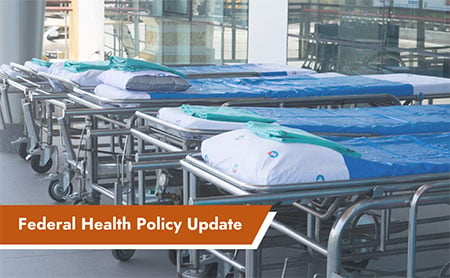Federal Preparedness Programs Support Health Departments
July 21, 2025 | Catherine Murphy

Funding the Hospital Preparedness Program (HPP) and the Public Health Emergency Preparedness Program (PHEP) is essential to maintaining readiness and response capacity at the local, state, and national levels. Both programs were originally authorized under the bipartisan Pandemic and All-Hazards Preparedness Act (PAHPA) in 2006 to equip state and territorial health departments with the resources to respond to disease outbreaks, biohazards, and other public health emergencies. Further, both programs support 62 recipients, including governments of all U.S. states, territories and freely associated states, Washington, D.C., Chicago, New York City, and Los Angeles County. As PAHPA reauthorization expired in 2023 and funding for these programs continues to be debated, sustained federal investment remains critical. Health departments and their leaders — state and territorial health officials (S/THOs) — are on the frontlines of every public health crisis. With support from agencies such as CDC and ASPR, S/THOs and preparedness directors utilize federal funding to rapidly and effectively safeguard public health through coordinated preparedness and response.
“Authorizing” and “appropriating" find themselves at the forefront of Washington, D.C. vernacular. And despite having two different meanings in policy, they are often conflated. Funding for federal agencies is provided annually through appropriations legislation such as the Labor, Health and Human Services and Education bill. Authorizing legislation provides the framework for grant programs and works through a separate congressional process. Congress can fund programs that are not authorized, and they have done so annually. However, in this current complex political environment, the Administration has indicated some reluctance to continue funding unauthorized programs. Moreover, the President’s budget proposal sets out the administration's priorities. The power to fund (or not fund) programs is the responsibility of Congress and, to date, they have continued to fully fund HPP and PHEP despite the lapse in authorizations.
Part of the Health Care Readiness and Recovery funding line currently within the Administration for Strategic Response and Preparedness, HPP is a critical component of emergency preparedness. Recipients receive funding and guidance to support health care coalitions — networks of health care and response organizations share resources, training, information, and communication systems to ensure regions are highly prepared for emergencies — in their jurisdictions.
The FY26 President’s Budget request proposes eliminating the Hospital Preparedness program and transferring Health Care Readiness and Recovery to the Administration for a Healthy America (AHA) with $30 million in funding. In FY25, Congress appropriated $240 million to the Hospital Preparedness Program.
The Public Health Emergency Preparedness Program (PHEP) bolsters state, territorial, and local response to public health emergencies including infectious disease outbreaks, natural disasters, and biological, chemical, nuclear, and radiological events. CDC also provides guidance, technical assistance, and other resources to recipients. PHEP funding ensures that health departments can establish robust emergency preparedness infrastructure and response plans to minimize impact of disasters.
The FY26 President’s Budget Request proposes $350 million, a $385 million decrease, for PHEP.
Congress is currently working on the FY26 annual appropriations bills for the upcoming fiscal year, which would provide funding for both HPP and PHEP. Markups are scheduled for the end of this month. Simultaneously, discussions are ongoing in authorizing committees. First passed in 2006, PAHPA authorized a number of preparedness programs (including PHEP and HPP) to manage health security threats. These programs were updated and modified through reauthorizations in 2013 and 2019; however, the authorization expired in 2023. Since then, some temporary reauthorization or extension of program measures were approved in continuing resolutions, including extensions for the Biomedical Advance Research Projects and Project BioShield in the full-year Continuing Resolution enacted in March 2025.
At the end of 2024, a bipartisan PAHPA reauthorization was included in a proposed Continuing Resolution (H.R.10515 - American Relief Act, 2025), which did not pass. Therefore, PAHPA remains in Congressional purgatory. Despite the generally bipartisan nature of PAHPA-authorized programs, Congress has shown little appetite for working on this issue and other health care extenders due to other competing priorities.
In recent congressional hearings, HHS Secretary Kennedy has spoken about the importance of pandemic preparedness and encouraged reauthorizing PAHPA, an encouraging sentiment on the administration’s priorities in supporting our nation’s public health readiness. In her Senate HELP nomination hearing on June 25, CDC Director Susan Monarez highlighted the importance of strengthening public health infrastructure and innovating to “prevent, detect, and respond” to threats using rapid, evidence-based decision-making. These sentiments potentially reflect support for prioritizing preparedness within HHS.
ASTHO will continue to strongly advocate for authorizing and funding preparedness programs. PHEP and HPP strengthen readiness by forging relationships between local, state, and federal public health experts, and ASTHO will continue to monitor changes to these programs and highlight their impact when meeting with Congressional offices.
Related Content
White House Releases Additional FY26 Budget Materials
This post has been updated. It was originally published on June 4, 2025.
View More